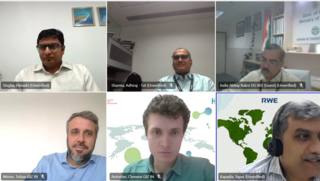Webinar on Green Ammonia (gNH3) Supply Chain - Production, Storage & Export from India via seaborne transport to the European Union
The International Hydrogen Ramp-up Program (H2Uppp) in cooperation with RWE Supply & Trading and the Indo-German Energy Forum (IGEF-SO) organised a webinar on Green Ammonia Supply Chain - Production, Storage and Export from India via seaborne transport to the European Union (EU) on 22 March 2024.
The production of green ammonia for domestic consumption and international export has strongly been considered under the National Green Hydrogen Mission of India as the country aspires to become a global hub for green hydrogen (GH2) and its derivatives. In this context, the Deutsche Gesellschaft für Internationale Zusammenarbeit (GIZ) formed a public-private partnership with RWE Supply & Trading under the H2Uppp program to investigate the viability and potential for the production, storage and subsequent export of green ammonia from India via seaborne transport to the EU.
In his welcome remarks, Mr. Tapas Kapadia, CEO, RWE Supply & Trading India Pvt. Ltd., was grateful to H2Uppp for the study and highlighted that the project was important to understand the feasibility of transport of green ammonia from India to Europe, including the available opportunities, challenges and infrastructure. The experts from Deloitte, Mr. Himadri Singha and Mr. Adhiraj Sharma, began the presentation by offering a broad overview on the scope of the study, followed by the findings of the techno-economical assessment and export infrastructure study.
Europe is expected to be a key offtaker country in the coming decades (the EU is likely to import more than 10 MTPA green hydrogen by 2030) which offers India the opportunity to emerge as an export hub. In this regard, incentive mechanisms such as the Strategic Interventions for Green Hydrogen Transition (SIGHT) and incentives for electrolyser manufacturing by the Ministry of New & Renewable Energy (MNRE) showcase the initiatives being taken on the supply side. India, therefore, is expected to have approximately 20 MTPA green ammonia capacity.
The Deloitte team has conducted a techno-economic assessment of the production, storage and export of green ammonia to increase the knowledge and expertise in India which is required for the market ramp-up of green hydrogen and derivatives, especially on the basis of the EU guidelines. A techno-economic scoping for 600 kTPA green ammonia production facility has also been conducted to understand the requirement of renewable energy (RE) configurations, utilisation and size of electrolysers and calculation of levelised cost of ammonia (LCOA).
Mr. Singha concluded that the key findings from the techno-economic assessment were that the selection of renewable energy plant location and optimisation of RE and battery energy storage system (BESS) sizing would be critical to optimize the LCOA. He also noted that leveraging grid power to the permissible limit would be important to optimize BESS capacity, while also optimizing hydrogen storage capacity to ensure continuous flow of hydrogen to ammonia loop and that these measures would help in increasing India’s regional competitiveness.
Mr. Sharma then took the audience through the options for seaborne transport of green ammonia from India to Europe and offered a glimpse into the current ports which are bringing green ammonia from global suppliers. During the webinar, he also emphasised on the safety aspects for the export infrastructure.
With over 120 participants, the discussion witnessed several questions regarding storage, plant size and trade of green ammonia. The webinar came to an end with an enriching set of closing remarks from Mr. Tobias Winter, Director, IGEF-SO, and Mr. Kapadia.
The presentation on the study by Deloitte can be found here.
Study on "The Green Ammonia Supply Chain: Production, Storage and Export of Green Ammonia from India via seaborne transport" can be found here.
If you are interested to learn more about the webinar, please find a recording here.
For everyone who is interested to learn about H2Uppp, all information can be found here.
